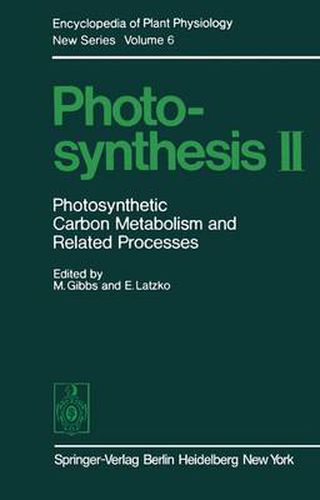Readings Newsletter
Become a Readings Member to make your shopping experience even easier.
Sign in or sign up for free!
You’re not far away from qualifying for FREE standard shipping within Australia
You’ve qualified for FREE standard shipping within Australia
The cart is loading…






M. GIBBS and E. LATZKO In the preface to his Experiments upon Vegetables, INGEN-Housz wrote in 1779: The discovery of Dr. PRIESTLEY that plants have a power of correcting bad air … shows … that the air, spoiled and rendered noxious to animals by their breath ing in it, serves to plants as a kind of nourishment.
INGEN-Housz then described his own experiments in which he established that plants absorb this nourishment more actively in brighter sunlight. By the turn of the eighteenth century, the nourishment was recognized to be CO . Photosynthetic CO2 assimilation, the 2 major subject of this encyclopedia volume, had been discovered. How plants assimilate the CO was a question several successive generations 2 of investigators were unable to answer; scientific endeavor is not a discipline in which it is easy to put the cart before the horse . The horse, in this case, was the acquisition of radioactive isotopes of carbon, especially 14c. The cart which followed contained the Calvin cycle, formulated by CALVIN, BENSON and BASSHAM in the early 1950’s after (a) their detection of glycerate-3-P as the first stable product of CO fixation, (b) their discovery, and that by HORECKER 2 and RACKER, of the COz-fixing enzyme RuBP carboxylase, and © the reports by GIBBS and by ARNON of an enzyme (NADP-linked GAP dehydrogenase) capable of using the reducing power made available from sunlight (via photo synthetic electron transport) to reduce the glycerate-3-P to the level of sugars.
$9.00 standard shipping within Australia
FREE standard shipping within Australia for orders over $100.00
Express & International shipping calculated at checkout
M. GIBBS and E. LATZKO In the preface to his Experiments upon Vegetables, INGEN-Housz wrote in 1779: The discovery of Dr. PRIESTLEY that plants have a power of correcting bad air … shows … that the air, spoiled and rendered noxious to animals by their breath ing in it, serves to plants as a kind of nourishment.
INGEN-Housz then described his own experiments in which he established that plants absorb this nourishment more actively in brighter sunlight. By the turn of the eighteenth century, the nourishment was recognized to be CO . Photosynthetic CO2 assimilation, the 2 major subject of this encyclopedia volume, had been discovered. How plants assimilate the CO was a question several successive generations 2 of investigators were unable to answer; scientific endeavor is not a discipline in which it is easy to put the cart before the horse . The horse, in this case, was the acquisition of radioactive isotopes of carbon, especially 14c. The cart which followed contained the Calvin cycle, formulated by CALVIN, BENSON and BASSHAM in the early 1950’s after (a) their detection of glycerate-3-P as the first stable product of CO fixation, (b) their discovery, and that by HORECKER 2 and RACKER, of the COz-fixing enzyme RuBP carboxylase, and © the reports by GIBBS and by ARNON of an enzyme (NADP-linked GAP dehydrogenase) capable of using the reducing power made available from sunlight (via photo synthetic electron transport) to reduce the glycerate-3-P to the level of sugars.